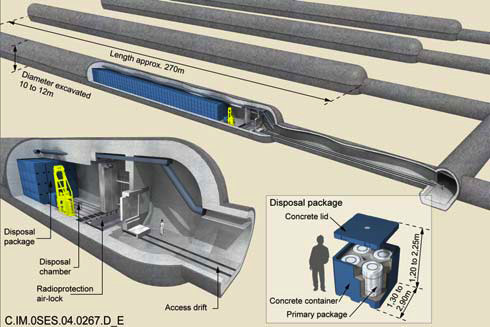Filling an intermediate-level waste disposal cell
Intermediate-level (ILW-LL) waste releases little or no heat. ILW-LL waste packages have a variety of sources. Their conditioning also varies. They may be stacked in large disposal cells excavated from the rock. The design of such cells is determined largely by geotechnical considerations.
To facilitate handling and placement, primary waste packages are grouped together and over-packed in concrete disposal packages that weigh between 6 and 24 tonnes and measure between 1.2 and 3 m in length. These disposal packages are stacked in the disposal cells, which are cavities around 10 m in diameter and a few hundred metres long.

ILW-LL waste disposal cell
Overview of the design and architecture of an intermediate-level long-lived waste repository. In the bottom right, primary waste packages are visible inside a concrete disposal package. The packages cube shape allows them to be stacked in long disposal cells, which would only be sealed when the facility is closed. The disposal cells extend into the rock in a parallel formations, and are connected to an access tunnel.
© Andra
Incoming ILW-LL waste packages will initially be received in above-ground buildings, where they will be inspected and unloaded from their transport casks. They will then be reinspected and if necessary placed in disposal packages.
Before being transferred to the underground repository, disposal packages will be placed in casks to provide radiation protection. Each cask will be placed on a funicular and carried to the underground facility via an access ramp.
Waste will be placed in disposal cells by robotic systems. All of the above operations will be performed by robots, as shown in the video.
ANDRA video Route taken by ILW-LL waste
ALSO : CIGEO High-level waste repositories
Other articles on the subject « Geological disposal »
Waste duration
Nuclear spent fuel and vitrified waste: what legacy? « Much of this nuclear waste will remain haz[...]
CIGEO project
CIGEO – Overview of a planned repository The efforts made by engineers to ensure that highl[...]
Clay medium
The Callovo-Oxfordian argilite The geological stratum or ‘host rock’ that will[...]
Bure underground laboratory
A research laboratory for a disposal facility site Before high-level radioactive waste is buried [...]
Results on deep clay disposal
What we know about the disposal facility site In its final report in 2006 the French National Ass[...]
High-level waste repositories
Disposal of high-level waste packages The high-level waste packages requiring disposal will proba[...]
Waste disposal USA
Back to the drawing board after Yucca Mountain WIPP, the first deep geological repository to begi[...]
WIPP Project
The world’s first deep geological repository The United States is the first country in the [...]
Waste disposal Sweden
Sweden and Finland – Exemplary waste management Sweden probably features among the E[...]
Other countries
Shared challenges and similar solutions In most countries with nuclear industries, solutions for [...]